Genet
Genetta genetta
The Genet has retractable claws like a cat
Advertisement
Genet Scientific Classification
- Kingdom
- Animalia
- Phylum
- Chordata
- Class
- Mammalia
- Order
- Carnivora
- Family
- Viverridae
- Genus
- Genetta
- Scientific Name
- Genetta genetta
Read our Complete Guide to Classification of Animals.
Genet Conservation Status
Genet Facts
- Prey
- rodents, insects, birds, and smaller reptiles
- Name Of Young
- kit, kitten
- Group Behavior
- Solitary
- Fun Fact
- The Genet has retractable claws like a cat
- Biggest Threat
- Habitat loss, poaching, roadways
- Most Distinctive Feature
- Its beautiful, soft spotted coat
- Other Name(s)
- Small spotted genet
- Gestation Period
- 78 days
- Temperament
- aloof and independent
- Litter Size
- 1-5 kits
- Habitat
- Woodland savannas, grasslands, coastal forest, rainforests, dry forests in the mountains, shrubland, near small, and seasonal lakes
- Predators
- Humans, snakes, honey badgers, leopards, servals, caracals and owls
- Diet
- Omnivore
- Type
- mammal
- Common Name
- Common genet, spotted genet
- Origin
- Africa
- Number Of Species
- 16
- Location
- Africa, north to the Iberian peninsula and France, east to Arabian peninsula
- Group
- Solitary
Genet Physical Characteristics
- Color
- Grey
- Black
- Cream
- Skin Type
- Fur
- Lifespan
- 13-22 years
- Age of Sexual Maturity
- two years
- Age of Weaning
- eight weeks
When is a cat, not a cat? When it’s a genet!
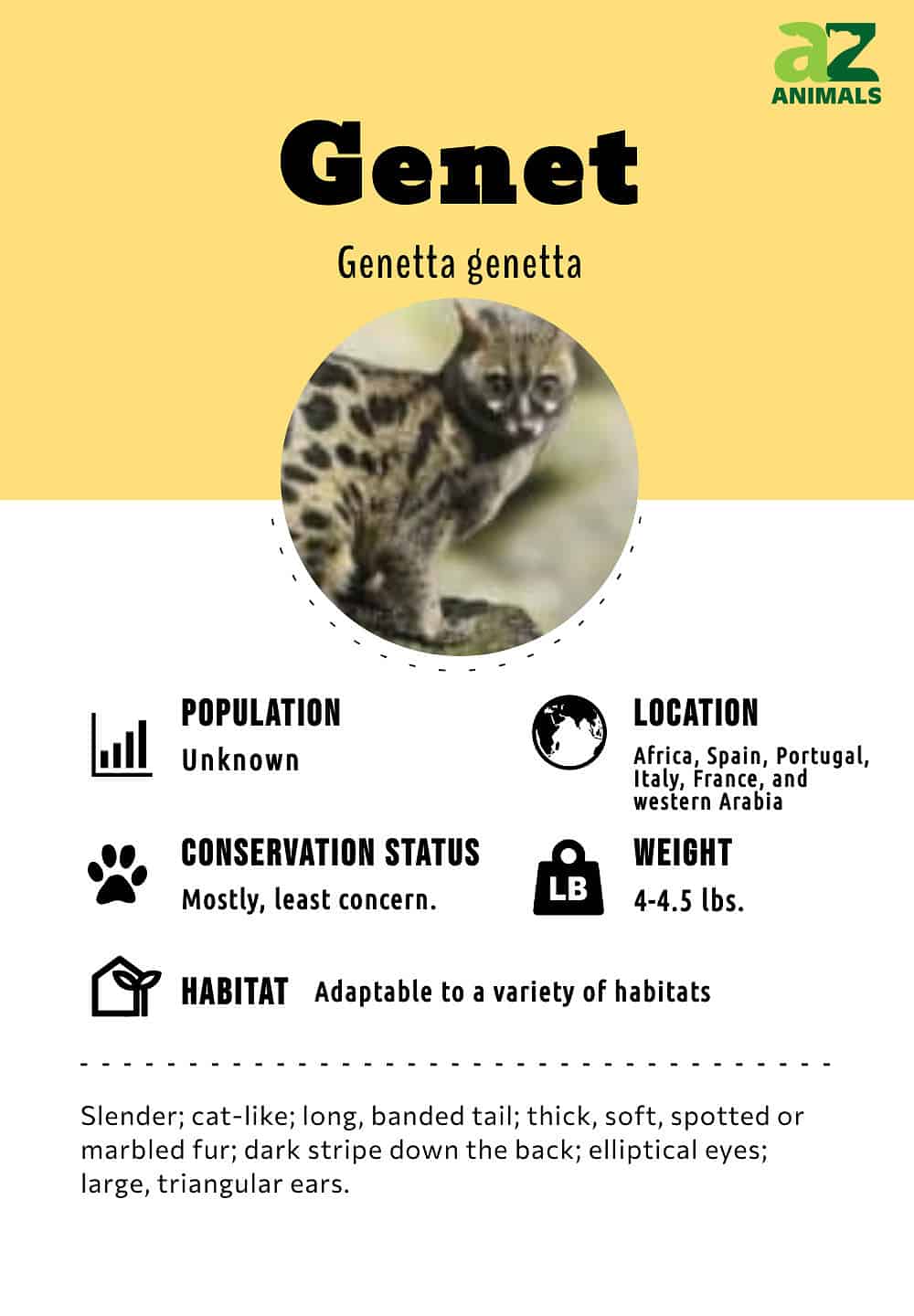
The genet is a type of animal called a viverrid. These animals remind people of cats and have many catlike qualities, including somewhat retractable claws and a well-developed hunting instinct, but they are more primitive. Scientists believe that the genet is the closest living relative to the ancestor of all carnivores. Besides some primitive features, these creatures also have longer snouts than cats and have more teeth.
Specifically, they have more molars in their upper jaw, and their teeth are not as specialized for eating meat. Because of this, cats are obligate carnivores, while genets can supplement a mostly carnivorous diet with fruit, grass, and seeds.
5 Incredible Facts!
Five facts about these beautiful and fascinating animals include:
- Like cats, they kill with a bite to the neck of their prey.
- Their claws allow them to climb trees easily and to hold down their prey.
- They have been known to hitch a ride on the backs of buffalos and rhinoceros.
- The small-spotted genet is the only genet species that live in Europe.
- It is the only viverrid (from the Family Viverridae) that can stand up on its hind legs.
Scientific name
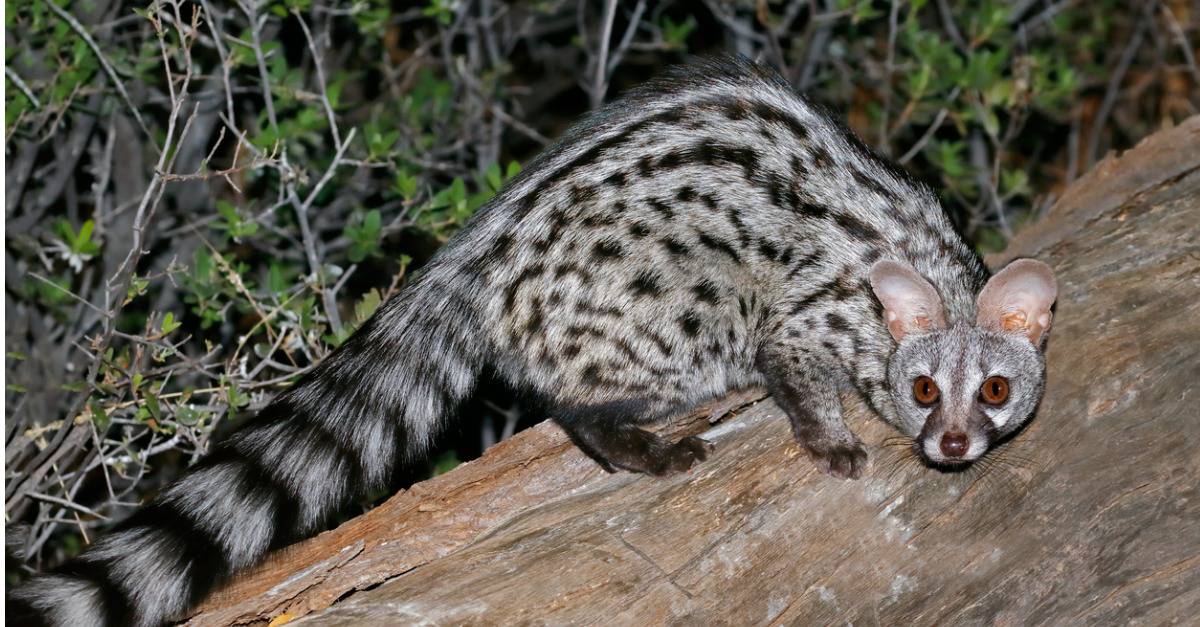
There are possibly 17 species of genet, a genus that has been in existence for up to 13 million years.
©EcoPrint/Shutterstock.com
The scientific name of the common, or small-spotted, genet is Genetta genetta. Scientists believe the name came from the Greek word for “bear,” which is “gen,” added to “etta,” the New Latin for “small,” so Genetta may mean “small bear.” There are possibly 17 species of genet, but that is still under debate. As of 2005, the following is the recognized list:
- Common or small-spotted, genet, (Genetta genetta)
- Cape genet, (Genetta tigrina)
- South African small-spotted genet, (Genetta felina)
- Rusty-spotted genet, (Genetta maculata)
- Pardine genet, (Genetta pardina)
- Abyssinian genet, (Genetta abyssinica)
- King genet, (Genetta poensis)
- Servaline genet, (Genetta servalina)
- Angolan genet, (Genetta angolensis)
- Giant forest genet, (Genetta victoriae)
- Hausa genet, (Genetta thierryi)
- Lataba genet, (Genetta letabae)
- Johnston’s genet (Genetta johnstoni)
- Aquatic genet (Genetta piscivora)
- Crested servaline genet, (Genetta cristata)
- Schouteden’s genet, (Genetta schoutedeni)
- Bourlon’s genet, (Genetta bourloni)
Genets are from the Family Viverridae and the Subfamily Genattinae. The genus Genetta became a separate group of animals from its genetic line about 9.5 to 13.3 million years ago. Then the species starting diverging approximately 8.5 million years ago, starting with the Hausa genet, followed by the Giant Forest genet about 4-6 million years ago. There is fossil evidence of the genet in Ethiopia, Kenya, and Morocco from 5-11 million years ago.
Appearance
The genet is a slender, cat-like animal with a body that’s between 16 inches to 2 feet in length and a tail that can be as long as its body. Females may be a bit smaller than males in some species, otherwise, males and females are the same size and weigh around 4 to 4.5 pounds.
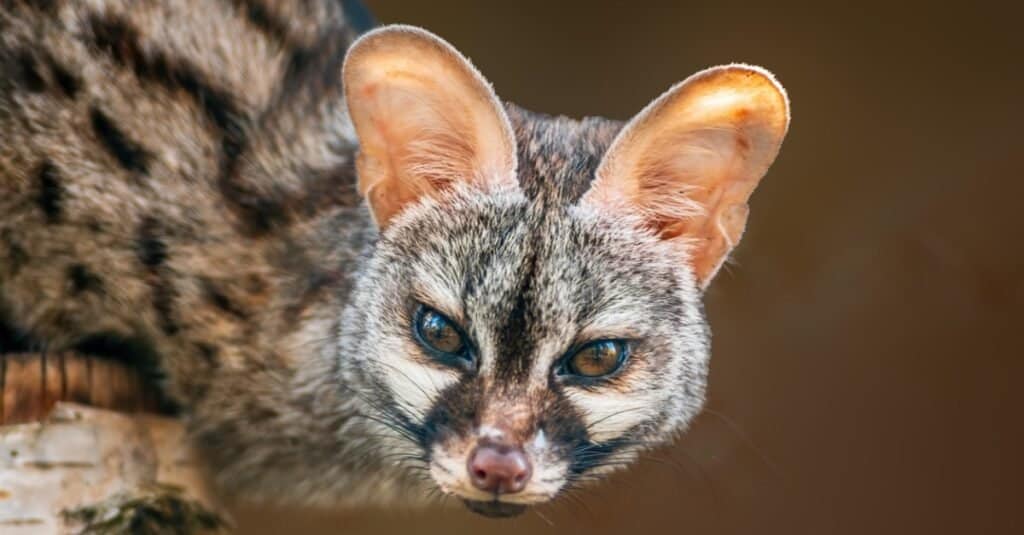
©iStock.com/Mario Plechaty
This viverrid is covered with thick, soft fur that is spotted or marbled, with a dark stripe down the back. It also has a crest along the back that can be raised when the animal is agitated. The tail bears dark bands or rings. Depending on the species, the tip of the tail can be dark or light. Some animals, such as the Huasa genet (G. thierryi) have a darker or lighter coat depending on their habitat. Those who live in the woods have darker fur, while those that live in the savanna have fur that’s lighter and shorter. The Aquatic genet (G. piscivora) is the only genet that does not have spots or rings.
The pupils of the genet’s large eyes are elliptical, much like a cat’s, and their ears are large, triangular, and have a great range of movement. The animal also has musk glands it uses to mark its territory.
Behavior
Genets are solitary and mostly nocturnal, though some also hunt at dusk and dawn. During the day they rest in a den or crevice. Their large eyes make it easy for them to find prey during the night, and they are lithe enough to squeeze into surprisingly small places. They can also run, jump, and climb with great agility.
Although the animal is an excellent climber, it prefers to stay close to the ground with its long tail held horizontally. It marks its territory and advertises its reproductive status through musk glands, urine, and feces. Along with raising the crest on its back and fluffing its tail, the genet tries to intimidate would-be predators by baring its teeth. There will be a price to pay for annoying it!
Habitat and Location
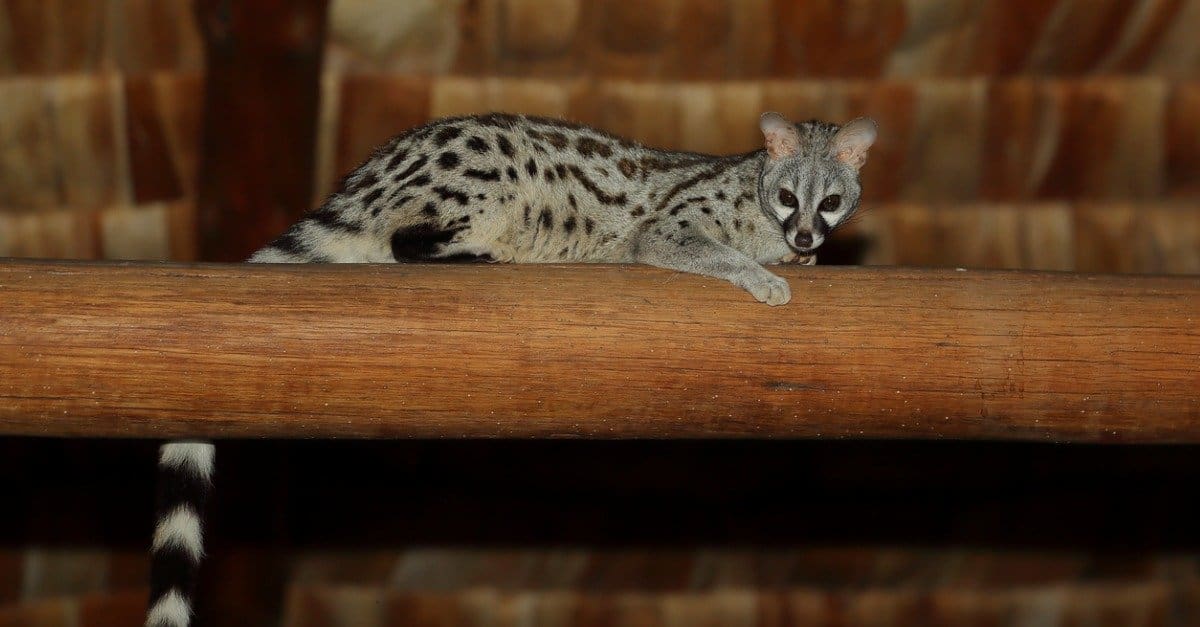
The Genet is of African origin, but different species have spread into the Iberian and Arabian peninsulas and beyond.
©iStock.com/Bebedi
The different species of genet are found throughout Africa, though the small-spotted genet is also found in Portugal, Spain, Italy, and France as well as central, eastern, and southern Africa and the western Arabian peninsula. The animal has benefitted from being adaptable to a variety of habitats, including savannas, shrubland, mountain forests, rainforests, bamboo and gallery forests, farms, and suburbs.
Diet
The genet is listed as a carnivore, even though it does not exclusively eat meat like a cat. It also eats fruit, seeds, nuts, and grass, though its main diet is made up of small vertebrates such as mice and other rodents. This makes them useful in areas of human habitation. They also eat small reptiles, amphibians, insects, and arthropods such as spiders and millipedes.
Besides having no spots on its coat, G. piscivora has teeth that have adapted to eating fish and aquatic crustaceans in its Congo habitat.
Predators and Threats
Humans are among the predators of genets. They are caught in traps for their fur and religious and medicinal practices, even if they are protected by the government of their country. Other creatures that prey on the genets are leopards, medium-sized cats such as caracals and servals, owls, honey badgers, and large snakes like pythons.
Genets eat small animals as well as plant materials such as fruit and seeds.
Reproduction and Life Cycle
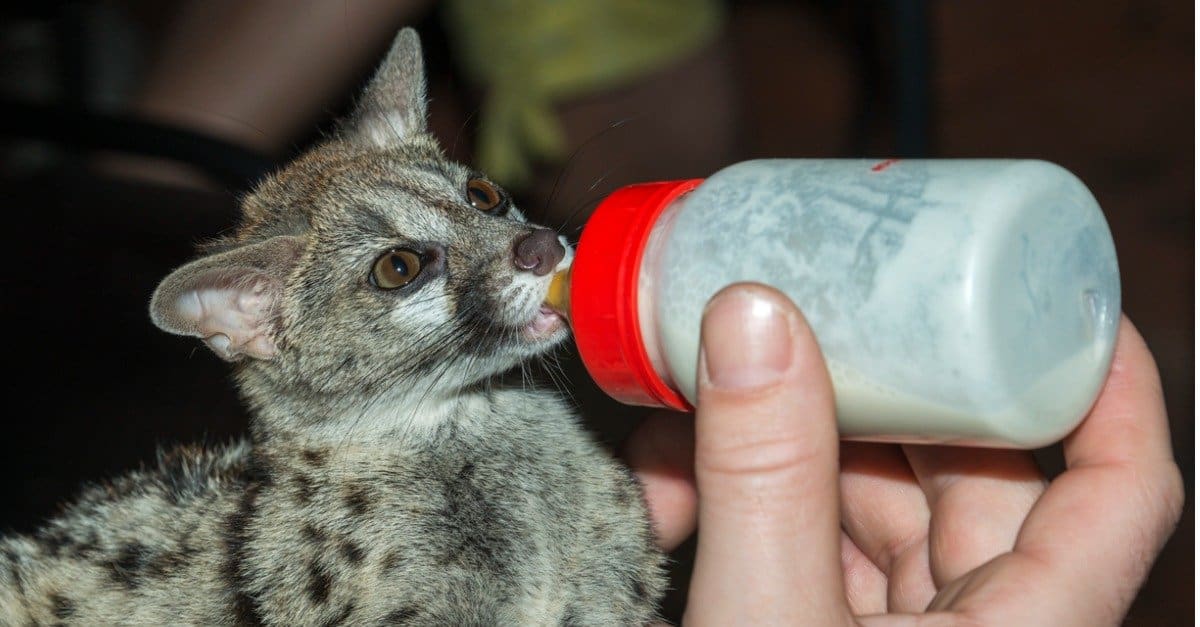
This baby genet is being fed by a human, but in the wild its mother will nurse it until it is eight weeks old.
©iStock.com/compuinfoto
The animal is solitary and only interacts with its conspecifics during the breeding season, or if it’s a mother that’s raising kittens. Females come into heat twice a year, during the rainy seasons. Copulation takes about five minutes, then the father leaves and has no part in raising the kittens.
The female is pregnant for about 78 days, then gives birth to between one and five kittens who are naked, blind, and defenseless. They open their eyes after 10 days and are nursed exclusively for about a month and a half. After that, they’ll start eating meat. They’re completely weaned when they’re eight weeks old. They become reproductive themselves when they’re about two years old and have a lifespan that’s as long as 22 years, though 13 years is more common.
Population and Conservation Status
Scientists don’t know the exact number of genets in the world, but most species are listed as least concern. The exceptions to this are Johnston’s genet, which lives in the forests of upper Guinea in Africa, and the Aquatic genet, which has been found only in the Democratic Republic of the Congo; they are considered near threatened. The crested servaline, found in Cameroon and Nigeria is considered vulnerable. There’s not enough data on the king genet or the Abyssinian genet to determine their conservation status.
View all 170 animals that start with GGenet FAQs (Frequently Asked Questions)
Are genets carnivores, herbivores, or omnivores?
Genets are omnivores, though they mostly eat other animals.
Is a genet a cat?
It is not a cat, even though some people keep it as a pet, which is not a good idea. The price of owning a genet is high, and not just monetarily.
Genets belong to a subfamily called Feliformia, which is a group made up of cats and cat-like carnivores such as hyenas and mongoose. So the genet can be said to be very distantly related to cats.
What is a genet?
This creature is a type of animal known as a viverrid. It resembles a long and slender cat and has a coat that is usually spotted or marbled with a ringed tail. Most of these animals are found in Africa, though the spotted genet is also found in Europe and Arabia. It has a lifespan of between 13 and 22 years.
Are genets good pets?
A genet does not make a good pet. It is even less biddable than a house cat, has sharp teeth and claws, and if it is upset it will not only use these weapons but spray whoever is annoying it with foul-smelling liquid unless its glands have been surgically removed. There are places where it is illegal to own a genet, but if a person is set on owning one, the price ranges from between $900 and $1400, not including shipping. These viverrids need a huge enclosure and must be caged when unsupervised to keep them from destroying the house.
Are genets endangered?
Most species are not endangered and their populations are stable.
What is a genet cat related to?
Genets are related to animals such as the spotted linsang, civets, mongoose, meerkats, the binturong and something that looks like a strange cross between a dog and a cat called the fossa, which is endemic to Madagascar.
Thank you for reading! Have some feedback for us? Contact the AZ Animals editorial team.
Sources
- African Wildlife Foundation, Available here: https://www.awf.org/wildlife-conservation/genet
- Bioweb, Available here: http://bioweb.uwlax.edu/bio203/s2014/sturz_jenn/classification.htm
- Garlyn Zoo, Available here: http://bioweb.uwlax.edu/bio203/s2014/sturz_jenn/classification.htm
- Cincinnati Zoo & Botanical Garden, Available here: http://cincinnatizoo.org/animals/large-spotted-genet-3/
- The Spruce Pets, Available here: https://www.thesprucepets.com/pet-genets-1239556
- The Natural History Collections, Available here: http://www.nhc.ed.ac.uk/index.php?page=493.172.297
- Integrated Taxonomic Information System, Available here: https://www.itis.gov/servlet/SingleRpt/SingleRpt?search_topic=TSN&search_value=621991#null

















